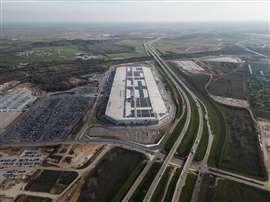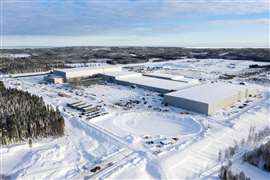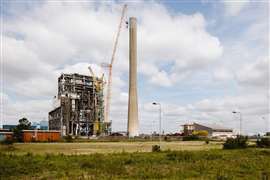How the world’s biggest EV battery gigafactories are being built so quickly
21 August 2023
As the world attempts to wean itself off oil, electric car makers and power storage companies are rushing to build factories capable of supplying the batteries needed. Lucy Barnard looks at some of the latest gigafactories to come online and the challenges that lie in building them.
“We need a place where we can be really big,” announced Tesla CEO Elon Musk, sporting an oversized cowboy hat and shades at the grand opening of the company’s vast Gigafactory in April 2022. “And there’s no place like Texas.”
Certainly, with a floor area of 10 million square feet (929,000 sq m), the giant facility where Tesla manufactures its Model Y electric vehicles and batteries, is big. Measuring three times the size of the US Pentagon, Musk claims it is the largest factory in the world by volume.
 A general view of the Tesla gigafactory in Austin, Texas, U.S., February 28, 2023. Photo: Reuters/Go Nakamura
A general view of the Tesla gigafactory in Austin, Texas, U.S., February 28, 2023. Photo: Reuters/Go Nakamura
“According to our calculations, you can fit 194 billion hamsters into this building,” Musk boasted at the livestreamed “Cyber Rodeo” opening party. “If you put the building on its side, it’s taller than the Burj Khalifa – that’s to scale.”
Yet, while Burj Khalifa took six years to build, construction teams completed the build of Giga Texas in its entirety in less than two years. Tesla’s 2.4 million square foot Giga Berlin was also built in less than two years. The company’s 9.3 million square feet Gigafactory Shanghai in China was reportedly built in just a year.
And these giant gigafactories – so named because they provide Giga Watt hour (GWh) levels of battery manufacturing output - are just the start of Tesla’s ambitious plans.
Currently, the company operates a total of five gigafactories around the world. The others are in in Fremont, California; Sparks, Nevada; Berlin, Germany; Shanghai, China; and Buffalo, New York (although not all of these actually currently produce batteries).
In January 2023, Tesla announced plans to invest $3.6bn more into Gigafactory Nevada, adding a 100 GWh battery factory and a new electric truck facility. In February, Mexican President Andres Manuel Lopez Obrador announced plans to build a Tesla gigafactory in Monterrey, Mexico, which is expected to start construction work this summer. And in May, Tesla announced plans to expand Giga Shanghai across another 172 acres.
But even when each of these reaches full capacity, the company estimates that this will not be enough to satisfy spiraling demand for its electric vehicles which Musk says will reach 20 million cars by 2030.
“Ultimately we will end up building, I don’t know, probably at least 10 or 12 gigafactories,” Musk said during Tesla’s results meeting in 2022.
And Tesla is not the only company embarking on ambitious gigafactory builds as companies around the world attempt to supply enough batteries for consumers to switch from petrol-driven to electric cars.
 Tesla Chief Executive Officer Elon Musk poses for a group photo at the Shanghai Gigafactory of the U.S. electric vehicle maker in Shanghai, China. Photo: Reuters
Tesla Chief Executive Officer Elon Musk poses for a group photo at the Shanghai Gigafactory of the U.S. electric vehicle maker in Shanghai, China. Photo: Reuters
Around the world, the number of giant battery factories is mushrooming.
“The term ‘gigafactory’ was coined by Tesla to mean a battery factory capable of producing batteries on the gigawatt-hour scale of capacity,” says Guillermo Martinez, battery sector lead at construction consultancy Turner & Townsend. “But it has become a bit of a buzz word and people use it either to mean GWh output battery assembly, or sometimes even to describe a large factory that produces something other than batteries.”
For battery manufacturing plants, Martinez says that a key feature is that they need to have a long linear layout in order to accommodate the machines which coat and dry long lengths of metal foils before they are pressed, cut and slit into anodes and cathodes.
China leads gigafactory construction
Currently, Asia is the continent with most gigafactories, driven by market-leader China.
“In China, Japan and Korea, OEMs have been producing EV batteries in these kinds of factories for more than ten years,” says Martinez. “But we see the industry in other countries in Asia, such as India, starting to grow too.”
Benchmark Mineral Intelligence, a specialist information provider for the EV supply chain, estimates that there are already 125 battery gigafactories operating in China, more than ten times the combined number in Europe and North America. Moreover, it estimates that China also has more than double the number of plants in planning or construction.
One of the largest is BYD’s vast battery plant in Western China’s Lithium-rich Qinhai province. The company, which is China’s largest EV manufacturer and which sold more cars than Tesla last year, announced in 2018 that the facility would comprise 10.7 million square feet and produce 24GWh a year.
Outside China too, the race is on to build bigger and better battery facilities, especially in South Korea, another major manufacturer of EVs.
The US is the region with the second largest number of gigafactories currently in operation, with many of these clustering around a newly emerging “battery belt” in the Midwest and South, close to the Tesla plants in Texas and California.
“Battery manufacturers are following different strategies over where to build gigafactories around the world,” Martinez says. “While many are looking to locate close to the OEMs they supply, others are taking into consideration other factors such as cheap land supply, government incentives, available skilled labour force, or a combination of these factors.”
US “Battery Belt” is growing
According to the US Department of Energy, US battery manufacturing capacity has grown from an annual capacity of 55 GWh in 2021 to 90 GWh in 2022 and is expected to grow to 177 GWh in 2023 and rising to 998 by 2030.
As well as the Tesla gigafactories, these include a $2.3bn, 2.8 million square foot battery factory in Warren, Ohio, built by a joint venture between General Motors and LG Energy Solution which began production in September 2022. The pair plan to build at least three more plants across the US to supply GM electric vehicles.
European governments too are attempting to lure EV battery makers to the region in order to retain auto manufacturing jobs and to cut its dependency on Asia.
Currently around 50 giga factories have been planned in Europe, although only a handful of these are currently operational.
 A general view of Northvolt facility in Skelleftea, Sweden. Photo: Reuters
A general view of Northvolt facility in Skelleftea, Sweden. Photo: Reuters
One of the best known of these is Swedish battery manufacturer Northvolt’s 5.4 million sq ft Northvolt Ett facility in Skellefteå, near the Arctic Circle, which started operations in May 2022, and which is expected to ramp up to a total capacity of 60 GWh a year.
For the contractors tasked with building gigafactories, the challenges can also be enormous.
Chris Evans, senior technical director at Arcadis points out that although the shell and core of the buildings are still traditional industrial sheds, inside they need to be built to specifications more commonly seen in the pharmaceuticals industry.
“The most onerous environmental requirement for battery manufacture is the demand for not only ‘Clean’, but also ‘Dry’ room conditions,” says Chris Evans, senior technical director at Arcadis. “These requirements have a significant impact on Mechanical and Electrical (M&E) systems and energy usage. In fact, their complexity can lead to M&E costs often making up more than half of the overall building construction cost.”
Evans says that ‘Clean’ rooms, typically need between 15 and 30 changes of filtered air an hour to ensure batteries are kept at a level of cleanliness that will not negatively impact their performance or longevity.
“With the majority of these clean spaces requiring exceptionally dry conditions, specialist dehumidification air handling units are employed, which rely on numerous moisture reduction techniques to achieve air dryness down to a dew point of -50o C,” Evans adds. “To put the relative humidity required into perspective, this dryness would not even be achieved in Lapland in winter. Without these low humidity levels and clean conditions, contamination of the battery anode and cathode coatings and electrolyte could occur, which would likely cause unacceptable levels of failure.”
All this means that even finding a contractor capable of taking on gigafactory builds can be challenging for battery manufacturers.
In Asia, where most gigafactories have been built so far, firms like China Construction Third Engineering Bureau - part of the giant China State Construction - have built up an enviable track record including projects such as Tesla’s Giga Shanghai. And yet, consultants say that lacking local connections and manpower, these firms would find it difficult to move into other geographical regions - while the sheer scale of work available at home makes it unlikely that they would try to do so.
In the USA, contractors operating in the advanced manufacturing sector, which includes battery plant construction, include Mississippi-based Yates Construction, New York-based Turner Construction and Texas-based Austin Commercial. While in Europe, contractors operating in the sector include Bouygues subsidiary Equans and Stuttgart-based Exyte.
And, consultants point out that the technology is evolving so quickly that by the time the building is completed, they could well have changed. This means that the construction team building a gigafactory must keep refining the design during the build programme - a process some project managers have likened to flying an aircraft while it is still being built.
“The entire industry is incredibly fast paced but it can lack maturity,” says Martinez. “In terms of designing and constructing a production building, ideally, the first step would be to design the building inside out, around the production machines. However, considering the long design and and construction timelines required in an industry with constant technological evolutions and high demand for equipment, you may not have the latest equipment available installed by the start of production if procured too early. So, flexibility and capacity are built into the design. When the production machine is finally selected, the design is refined and the integrated project schedule aligned to the machine manufacturing timelines.”
Gigafactory Power List:
Giga Texas
Location: Austin, Texas, USA
Construction start date: July 2020
Completion date: April 2022
Costs: $10bn over the long term according to Elon Musk – but initial costs around $1bn
Size: 10 million square feet
Capacity: 5,000 cars per week in May 2023
Giga Shanghai
Location: Near Lingang, Shanghai, China
Construction start date: December 2018
Completion date: December 2019
Costs: Total minimum investment requirement of $2bn.
Size: 9.3 million square feet
Capacity: 80,000 cars a month in September 2022
BYD Battery Plant
Location: Qinhai, China
Construction start date: June 2018
Completion date: 2019
Costs: Undisclosed
Size: 10.7 million square feet
Capacity: 60 GWh per year
General Motors and LG Energy Solutions Battery Factory
Location: Warren, Ohio, US
Construction start date: May 2020
Completion date: August 2022
Costs: $2.3bn
Size: 2.8 million square feet
Capacity: 40 GWh per year (with room for expansion)
Northvolt Ett
Location: Skellefteå, Northern Sweden
Construction start date: October 2019
Completion date: May 2022
Costs: Total project costs of $2.6bn
Size: 5.4 million square feet
Capacity: Planned full capacity 60 KWh per year
STAY CONNECTED


Receive the information you need when you need it through our world-leading magazines, newsletters and daily briefings.
CONNECT WITH THE TEAM











